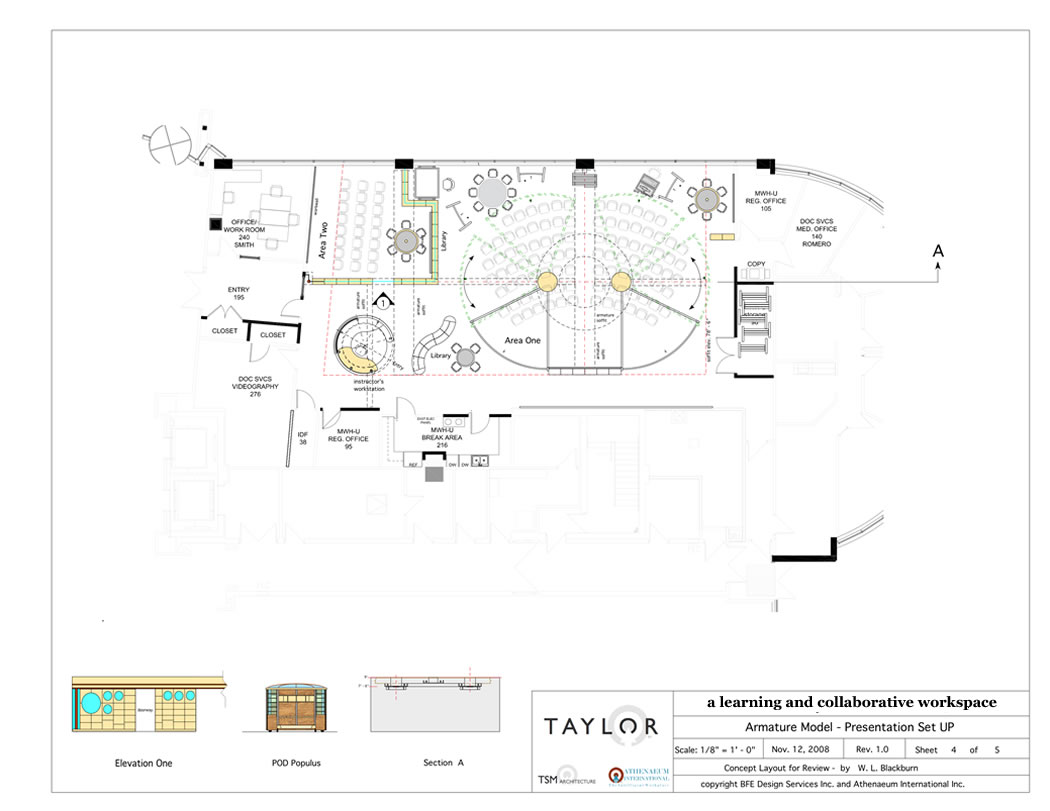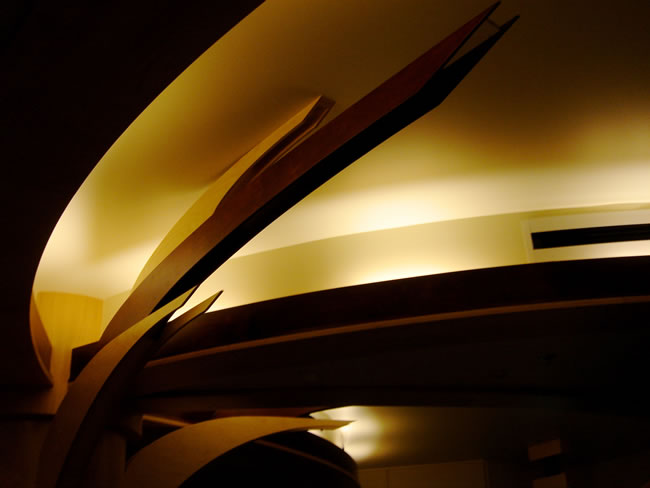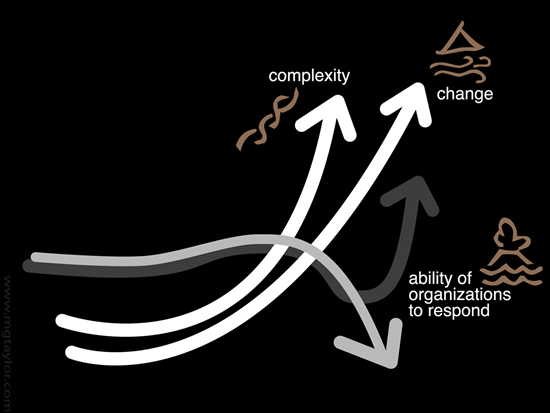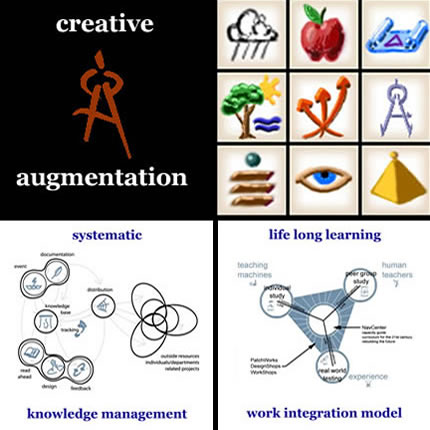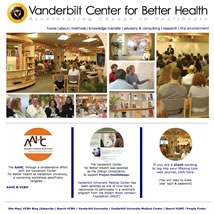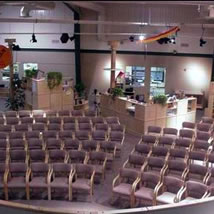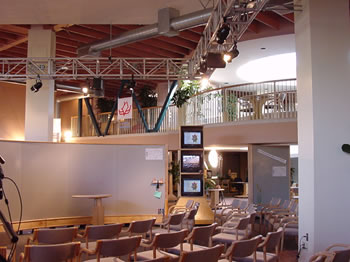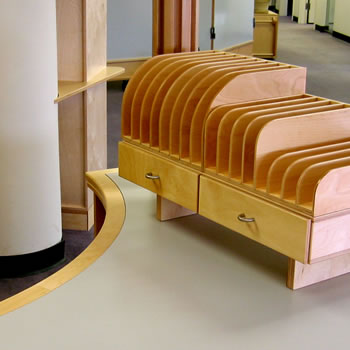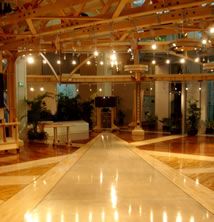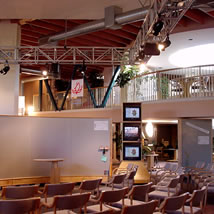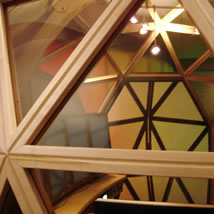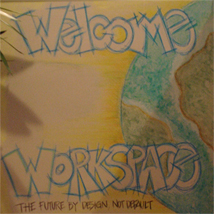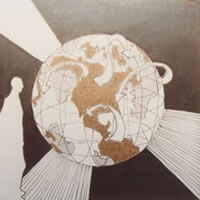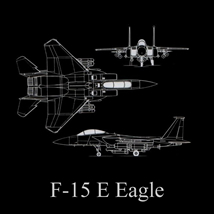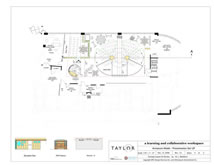for background GoTo: 20 Years of Taylor Environments |
Concept: a Learning and Collaborative Work Space
for a global engineering company
TSM Architecure Work # 183
|
November 2008
part two of two
|
click on graphics below for MG Taylor ValueWeb® Members who focus on education, training and management development applications of our system |
|
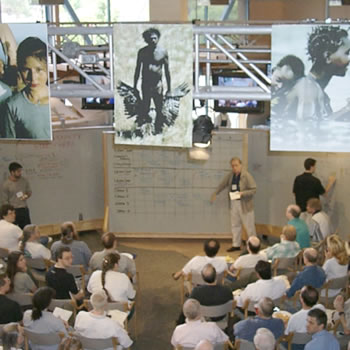 |
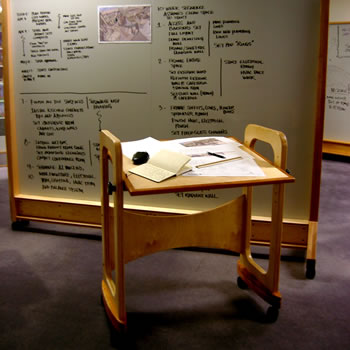 |
Mies van der Rohe said the “God is in the details.” This is certainly true in all aspects of an environment from design to manufacturing, building, equipping, use and management of the space. At MG Taylor, we have a saying that “everything speaks.” Every piece has utility - is does something. Every piece is the consequence of having solved a problem - you can see this process made objective. Every piece has to be made - it is the consequence of and era’s technical, industrial capacity. Every piece is selected - it represents an economic choice and statement of economy. Every piece is an esthetic expression - it is the consequence of a world view made concrete through the act of turning ideas into reality. As such, everything can be regarded as a unconscious “instruction,” to those inhabiting the place, about the nature of existence and the cultural values of a time, society, enterprise and group of its members. In this context, the built environment is the employment of our values - the consequence of our decisions, the expression of what we believe is important, a statement of where we stand. |
| At MG Taylor, we use the term navCenter, for the environments of learning and collaboration we build. Our customer-partners call them many things: Learning Exchange, Fusion Centers, corporate university, Accelerated Solution Environments and so on. We use NavCenter because we think of these environments as ships with which to navigate an unknown future. How do you systematically find your way in the circumstance where you are making the chart in real time as you are using it? Those who use these environments, name them to emphasize the specific aspects of this broader task which they have choose to focus on. As a consequence, these many centers - scattered around the world - have many things in common and many aspects unique to each. It has long been a practice for these Canters to share nonproprietary learning in order to raise the state-of-the-art of all. |
| It is a basic premise of these Centers that the activities associated with learning, work and living should not have to conform to and be limited by the built structure - the environment should adjust, gracefully and easily to the tasks and the moods which support them. This means these environments have to be highly adaptable - not just by putting tables on wheels and providing some room divers. This is a low “adjustability” factor and does not intrinsically make the space different, just smaller in the case of the room dividers. Nor is it acceptable for the environment to look transient and temporary and to be awkward in shape and form when these “adjustments ” are made. No, the environment should be perceived as solid and be experienced as “right” in each configuration. This means it has to be designed from the beginning to be able to do this and so that its many components are manufactured to move easily and to reassemble in a variety of interesting and useful ways. In doing this, we design to several time envelopes: what can move in a second, a minute, an hour, a day? And, what never moves except in a major reconfiguration or construction? The furniture pieces and components have to be conceived and made to combine in actual clustered hierarchies of functional mobility. This also means that individual pieces, components and spaces can be used - without major reconfiguration - for different functions. It means for each individual case, a careful determination of just what should be movable and not is necessary. Adaptability is not an end in itself. The right level is that which serves today and is sufficient for tomorrow’s requirements without major investment. A good test is when different users can employ the space for different purposes, dress it to give it their signature, all the while feeling that it was designed just for them for doing just what they are doing now. |
| This approach requires an unusual level of User Participation. This is not only a necessity, it is a feature of the system. We want users to be active in the maintenance and running of the environment - to work the landscape and to be an active part of the community. Much of modern life has been outsourced and made “efficient.” This has its use yet can be taken to extremes. Many in the workplace today are alienated and do not feel a part of it. There are many factors which promote this attitude and sense of isolation. They can be found both in the processes predominate in the environment and in the environment itself. Can you go to your workstation and leave at the end of the day without engaging co-workers or interacting with knowledge “objects” - we call them “agents” - which document the work of the enterprise and your team? When you walk into a group space is it so singular, generic, without variety and nuance, that you cannot find a place which is comfortable for you? Is your workspace so unchanging that after awhile you do not see it at all? Is the commons spoiled so that you feel you are always walking through someone else’s mess - or is there no commons at all? Are you always “fighting” your workstation because it does not support your personal patterns? Is your personal space a true expression of you within the identity of the team or group you are learning and working with? Do you feel connected with, responsible for and actively engaged in the keeping, organization and set up of your workplace? Do you feel free, with your co-workers to experiment, change with and re-order it? Are you pleased by it, comfortable in it, able to sense the greater environment - building, campus, city, region, world - of which it is a part? Do you feel you could be anywhere, somewhere, nowhere - that you have no sense of PLACE? Can you sense the passing of the day and seasons or are you removed from the cycles of nature? Can you control temperature, lighting, sound, inclusion-exclusion, and modulate these with the learning or work task with which you are engaged? Do you assume that these questions are irrelevant to the workplace? Your responses to these questions are an indication if the place where you spend a big portion of your life is indeed a “natural” environment for who you are. These question also call into question the standard “corporate” and “institutional” approach to the making of learning and work environments. Signature and brand are good - dullness is not. Continuity is good - sameness is not. A solid shelter and sense of protection is good - rigidity is not. Flexibility is good - random, meaningless, ubiquitous, undifferentiated spaces are not. We evolved to be tuned in to our environment and in fact we still are. The question is what is our work environment “telling” us and if this is supportive and expressive of our corporate purpose, personal nature, and the task at hand? Ad people and movie makers know how to get ideas and emotions across with shapes, sounds, images, worlds, music and textures - is architecture lacking in these media? what is your environment telling you about reality, yourself and the society of which you are a part? |
Criteria for making and using creative workspaces:
The environment will reflect, embed and exemplify the highest values and culture of the organization and society it serves - it will demand these values of the environment’s users in the performance of their work and conduct.
The environment will not force those using it to compromise their process to the arbitrary limits of the environment - it will quickly and easily adapt to the specific task at hand thereby augmenting the specific learning, individual and collaborative work processes as required by each individual, team and group.
Technology will be embedded and transparent - it will never be used in a way which gets between individuals and each other or the content which they are learning and using.
All of the learning and creative skills and intelligent modalities will be supported - individuals will not be asked to perform by being placed in an environment which is intrinsically hostile to their cognitive nature and developed skills
The environment will be natural - it will offer prospect and refuge, reflect the seasons and passing of the day, employ warm materials which are safe and healthy, stimulate the senses, provide a landscape to “hunt” in and explore.
The environment will be media-rich - all media is multimedia not just computers and video. Pen, paper, paints, modeling materials, books, markers - all - have to be used for input: learning and information gathering, and for output: design and project management.
The environment will reflect the variety of life and be requisite with the variety demands of the applications to which it is put - little “v” cannot match big “V.”
The environment, its components and pieces will be durable - not a fashion driven, cheaply build throw away expression of impermanence - this is not economical nor ecological. Life-cycle economics should rule with all costs and benefits a part of the calculation. Even in situations of transience, a full service fully functional, human supporting environment is possible and can be made movable with economy and 85 to 95 percent of its capital value reusable.
The environment is Montessori School-like - everything having a place - when used - when not - so that neatness, fast reconfiguration and handing off to other users is facilitated.
The environment will be upwardly enhancable - it will be designed and built in a way which facilitates the introduction of new technologies and work processes.
It will be playful - as important as the economic conseqence of work is, creative work is an end in itself. It is what we invest the majority of our life-time doing - even those who do not need to work. “If you cannot have fun with the problem, you will never solve it” --- Taylor Axiom. |
These are demanding criteria. With each project, they have to be accomplished in balance with the traditions, economics, schedule and physical constraints of each time and place. To balance does not mean compromise. It means to find the best trade-off among all of the elements which make up the design challenge equation. Doing so successfully is an important demonstration of integrity to the uses - they are not asked to do something, within the space, which the makers of the environment were incapable of - or not willing - to work through to a quality result. |
| The many components of the system have to Plug and Play in order for the environment to work properly. Flexibility has a cost. Everything has to have a place when not used. Power, Lighting and multimedia have to be as adjustable as the WorkFurniture itself. Reconfiguration is usually spontaneous. This means it cannot be scheduled and subject to the availability and costs of technical experts. The user has to be able to “run” the space to the maximum possible degree. There are a variety of design strategies for accomplishing this. And, once accomplished, in the technical realms, the users have to be educated in the use of the system and the necessary steps for its “fine tuning.” Flexible environments raise code and safety issues which have to be considered. A 16 foot WorkWall placed in front of a fire exit is not a good idea. In the future, employing technology coming available and soon affordable, WorkFurniture will “know” where it is and its rules-of-placement - this will give pieces the ability to “announce” when they are out of place from safety, usability and esthetic perspectives. This wireless system will locate every piece on a screen so that the full utilization of the environment can be understood and improved. Until then, this has to be the “ hand and eye” work of the users. This is not complicated - yet critical for the space to work properly. There is a metaphor here and it addresses the issue our use - and sometime abuse - of our technology. Cars can provide on-demand individualized transportation. They also can be a means of slaughter on the hi ways and significant polluters and energy hogs. Over use can cause significant geopolitical and economical stresses. There is a dangerous tendency, in our society today, to take convenience too far and remove the user from understating - and being in control - of the tools being used. The issues of responsibility and consequences do not go away - they just get lost out of sight to pop up “suddenly” in a “crises.” USE has to be built in to the design and installation process of any tool or environment. It is interesting to note that complex systems rarely come with a user manual. Learning the hard way is not a good idea. From the MG Taylor perspective, user engagement in the environment is not an “oh well, have to do” issue. It is a necessary feature of the system. If designed right “driving” is fun and necessary for understanding and the exercise of personal responsibility. Removing unnecessary, repetitive, dull work from the production process is a good idea. Going too far and disconnecting people from the mental and physical reality of work is not a good idea - the consequence of this is disembodied actors removed from feedback and the consequence of their acts. This can be seen all over in our industrial economy. It is a small thing, the work environment, yet a good place to begin the process of putting people back in the process of work. Different results will emerge. |
|
|
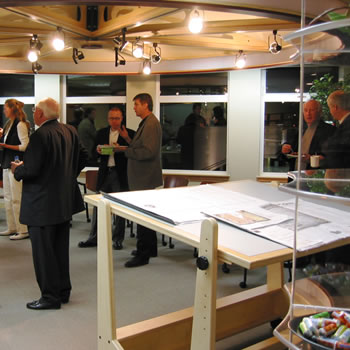 |
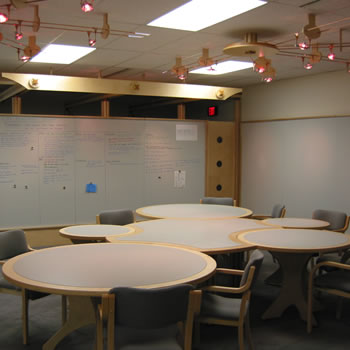 |
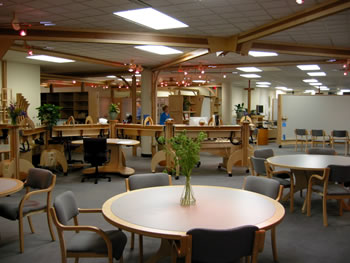 |
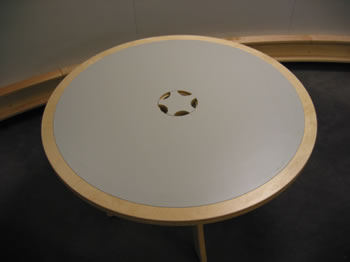 |
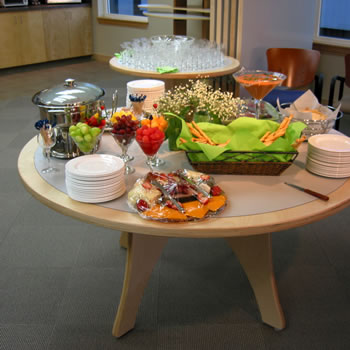 |
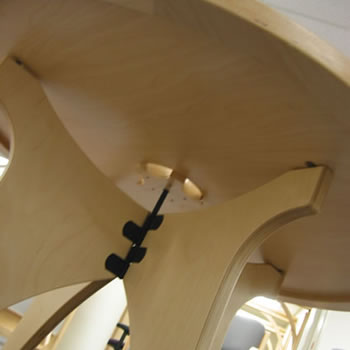 |
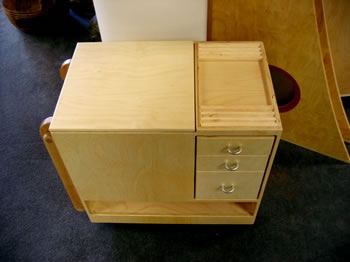 |
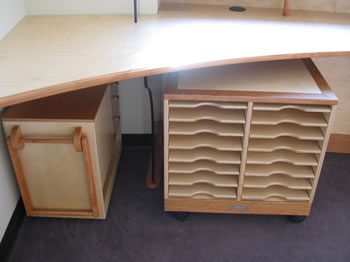 |
|
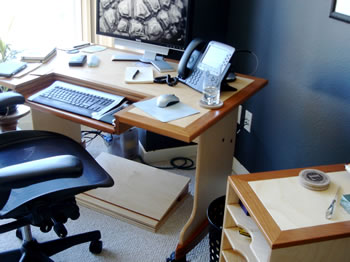 |
|
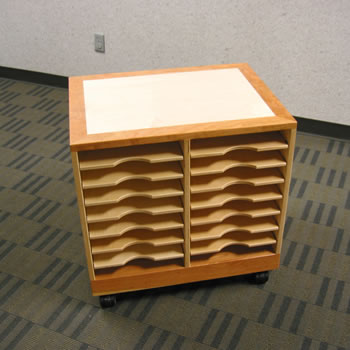 |
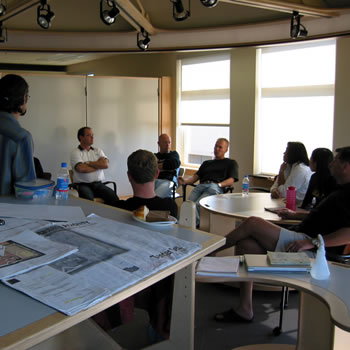 |
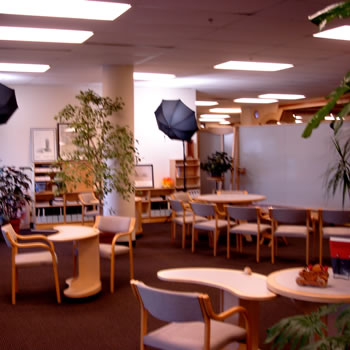 |
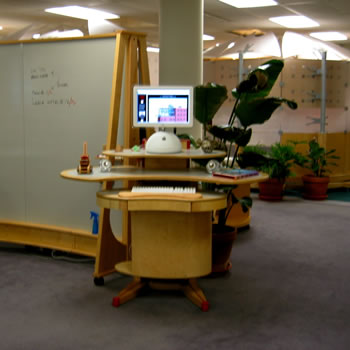 |
 |
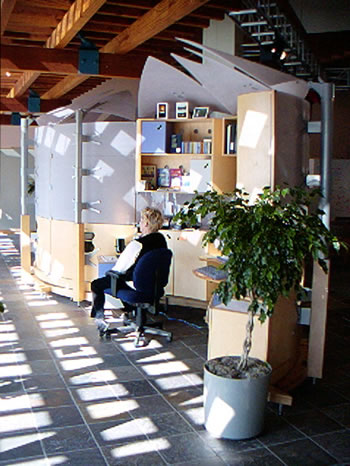 |
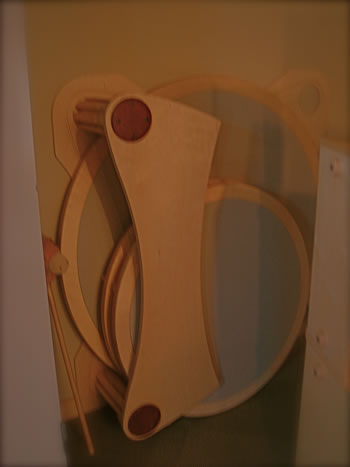 |
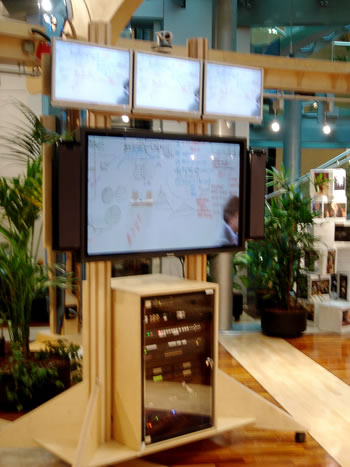 |
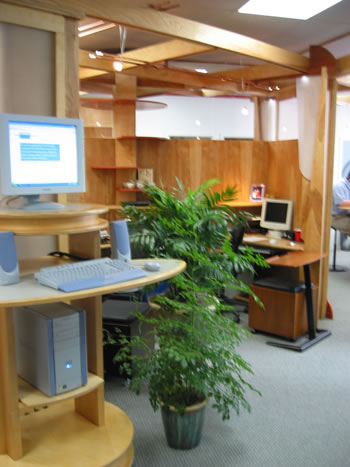 |
AI Armature and CubeOffice Componets
|
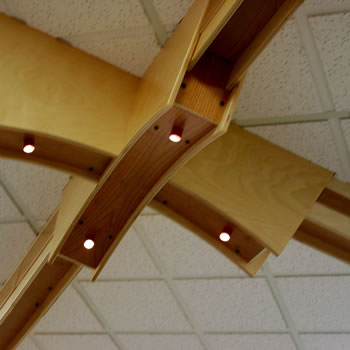 |
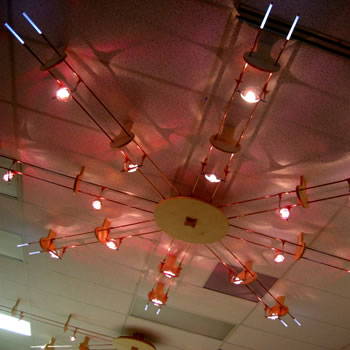 |
The AI Armature System provides a number of key functions: |
It transforms a nondescript box into an unique space which has character and delivers a strong corporate identity.
It supports the technical system of the environment providing hangers for video display, capture and projection systems; direct and indirect lighting; wiring chases for plug and play power, computer and multimedia feeds; hanging capability for banners, pictures, models and sculpture. |
| In a typical Taylor environment, the Armature is the one major fixed element which then allows a wild variety of set ups employing, architectural scale, movable components without sacrificing overall visual and organizational continuity. It is possible to build Armature that themselves move the Gantry-WorkWalls and various “Tree” elements being an example. |
| The Armature provides a layer between the ceiling, or the open space above, and the scale of the those using and employing the space. This promotes both human scale and also a sense of greater space by introducing different “head” heights and an entirely different lighting plane than, unfortunately, the typical work place affords. The Dan Newman Studio in Rome [left] is an example of the play of light and thus enhanced space that can be accomplished even with a normal height structural ceiling. The Armature facilitates the ability to create prospect and refuge vertically as well as horizontally thereby making a more human friendly space and avoiding the “flat earth” effect found in so many large, open - should be called “space-less” - commercial properties. |
| Acoustics have been long neglected in the workplace. Other than dampening sound with so-called acoustic ceilings, and carpets, little thought or play seems to be invested in making the space come alive. A too dull space is worse than a too lively one. Sound is one of a human’s major senses and, like touch, continually provides important information about the world we live in and our security in it. It seems to be the goal of modern architecture to remove these two senses from the human experience. If you were to walk into a 19th century European concert hall - or almost any building - you would be struck by how much you have been “missing” this vital connection with physical reality. People are often not aware of these deprivations yet, nevertheless, are effected by them. This is one, of many, reasons why they are not comfortable in commercial settings. In this state, learning and productivity is negatively impacted be this commonly recognized or not. One of the most common comments we get from people using our environments is that they “feel so comfortable.” Once, a woman walked into the PA knOwhere Store and burst into tears. I asked her what was wrong and she said that “had not felt so sheltered and protected in a long time.” A sad commentary on the modern world. I took her over to our library and gave her Christopher Alexander’s Pattern Language and explained how the space she was in was an application of these principles, and that, she could apply them in her own home and workspace. The Armature breaks up unwanted sound wave propagation. It also alters the acoustics of the space immediately below it creating a more natural, variable environment. Armatures can also house active sound sources like speakers which do mush better there than buried in a sound absorbing ceiling. Some people are visual, some verbal (hearing) and some kinesthetic. Too often, they are put in bland environments with none of their senses stimulated, put into a passive position and deprived of movement while holy truth is projected at them. We wonder why, it is claimed,they do not learn and are not creative. They hear what they are told but the learn what they experience. It is the total message which goes into memory. What the environment (the sound track) and the process (plot structure, tempo, engagement) teaches often contradicts and drowns out the message rather then augmenting it. These are issues of intent, authenticity and integrity. |
| This brings us to Variety and Requite Variety. If you ask people where they go and what they do on vacation, you will get many answers. Some will go to the city. Some to the wilderness. some to the beach. some to another land and culture. If you ask them why, they will say “to go to the theatre,” or “to camp out and get away from it all,” or “to dive and surf with the kids,” or, “ meet new people, see new things and get out of myself,” and so on. The answers are without limit. Yet, if you keep on asking and asking there emerges a simple answer - no matter the way to it, or the definition of it, most are seeking variety. If, then, you ask them, to describe their physical learning and work environment, the majority will say it lacks variety, that it is dull, that it seems to be the deliberate attempt to erase difference and variety. Often, they are shocked by this self-realization. Life is a high variety experience. Learning and knowledge work (what most of us do - even modern “physical” work) are high variety activities. Humans are attracted to difference - this is why television is so addictive. The issue of requisite variety is to get the variety equation balanced. Too often curriculum and problem solving challenges are dummied down so that “everyone can get it.” We bore people by putting them in a dull environment with spoon fed information, little real connectivity to their interests, or work and real life experience. The answer is complexity (not complicatedness). The environment must be high variety to stimulate and to adjust and become the right place for each activity - you do not go to the mountains to swim with whales and dolphins. The content has to be rich and all around in various forms to awaken the hunter gatherer in us. The process, a good piece of engineering to fit the task at hand. Tools must be well crafted and carefully selected - surf boards don’d work well in downtown Manhattan - and they must fit the task and the mind-body sense of each individual user. Low variety environments - physical place, process and tooling - do not promote complex, comprehensive, systemic answers which is what we all are challenged to create today. |
| The Cube Office System is built up using a one foot deep by a two feet high and wide wood box which can be put together in different ways. This is a sophisticated application of the old child’s toy storage cubes. Inside this basic module, storage units, pull down secretaries, work tops, lateral filling cabinets, and many other items can be fitted. This can be done as a single wall or as a double wall with a space in between for sliding doors. This is usually the case when offices and spaces requiring acoustic attenuation are built. The mass of books, files and stored items aid in this sound proofing. It is possible to assemble these rooms in such a way that they can be disassembled, moved and reassemble in a few hours using simple hand tools. Combined with WorkWalls, Armature elements and the plywood “platform” - which is the basis of our WorkFurniture - an extraordinary range of spaces and “rooms” can be created. The degree of enclosure or openness between these rooms and other spaces can be “tuned,” to a fine degree, by the size of sliding screens and doors, use of clear, translucent and opaque materials, the height of the cube walls themselves and the combination of all these factors. The photos on this page are from 10 projects spanning twelve years. They show, yet by no means exhaust, the variety possible with this way of building. They also demonstrate that short term “stylistic” concerns does not dominate the work as the goal is to create something of long lasting, utility, endurance and esthetic quality. The production method is “lean” - a careful combination between craft and production - and mass customization - the maximum possible of unique design solutions from the fewest and simplest pieces and manufacturing processes. One of the features of the AI manufacturing process is that it is possible to repair, add to, move and readapt these environments as circumstances require. Steward Brand, in How Buildings Learn, profiles the process of how the human-built ecology changes over time. Unfortunately, few buildings - and almost no interiors - are designed to to this without extensive, expensive and time consuming effort. The consequences of this are neither economical nor ecological. The IRS may allow a scheduled depreciation write-off of construction and furniture, this does not mean the practice of throw away environments is sustainable nor that the slow decline and compromise of most works, as they go through changes they were not designed to accommodate, is an example of effective stewardship. The environment is an the embodiment of the values and history of a community of users. Both tradition and future should exist as a continuum to properly house the work of an enterprise. Authentic architecture does this. It is built values. It is a society and an enterprise telling its members what they represent and stand for. Utility is important and critical - the message in the medium is as critical and cannot be faked. It is interesting and amusing to see the craft with which companies will design and package their products and services - and the care they will bring to advertising them - is often neglected when housing the employees who produce these very products and services. Apparently, many believe that what effects and motivates us as a user and customer does not as a creator and producer. |
| The Cube Office Layout for this project can be installed during phases a, b or c. The modular units are applied in a way which keeps modularity, fits the space and adds utility: a nook for parking the drafting table and a second work space within Area Two. This space has a folding-out WorkWall, which provides 98 square feet of work surface, when open, for extended team sessions. The layout starts by aligning with the exterior wall column. This connection is reinforced by the Armature- soffit indicated by the dotted lines. The wall then jogs around, as noted, then turns towards the existing wall. This existing wall is angled and a side light is misaligned with the new assembly [left hand lower corner of Space 2]. Rather than kludge together these two different elements, the cube wall terminates by “standing away” and is connected by a floor to ceiling fixed glass double corner window. This provides a narrow look in and out, space to space, viewing which keeps the distinction and integrity of the existing work and the new while adding interest. The same happens at the termination of the cube wall and the column where a small sliver of glass keeps the two elements independent. There also is a practical construction reason for doing this as built-in-place walls are rarely perfectly plumb, thus incompatible with manufactured goods. A stand away technique makes fitting easier. Glazing is also used over the Cube Office installation for all of the same reasons. The end result is that the wood mass of the Cube Office seems to float in the space - connected and integrated yet free. This way of fitting the Cube Office components also makes reconfiguring or relocating Area Two easier if this becomes necessary. Area Two provides a privet space for up to 25 people. It walls can be book and display cases, storage units, files and pull out work stations. The space can be configured to be relatively visually closed or open as the pictures show. |
| The Possibilities of this approach to interior environments are many. In the majority of commercial office space available today, the “architecture” stops at the building shell, the Entrance and Lobby and perhaps a few added features. The actual office and work areas are left “generic” so that users can “customize” their own space. This usually requires expensive lease hold improvements - often to be torn out and redone with each new renter or group - or the alternative to this: “open space” planning. Both of these approaches can be very good. Both have strengths and liabilities. Building is often expensive and non adaptable - this works when requirements remain fixed and occupation is lengthy. Open office systems today are sophisticated yet tend to adhere to a narrow concept of work and collaborative processes and are rarely as adaptable as necessary. It usually take extensive and well designed lease hold building, carefully coordinated with a specific manufacture’s furniture line, before an architectural scale environment - unique to a particular company - which creates, signature, brand and PLACE, can be achieved. Both of these standard approaches tend toward special-use spaces: work here, meet there, go someplace else - usually off-site - for large gatherings. This is all expensive and time consuming. The Taylor- AI system is intimately tied to a broad range of work processes, adaptive on several scales of size and time, allows a wide range for expressing individual enterprise cultures, employs an economical platform approach, is made of human friendly woods, projects a “classic” look free of style-ism, is built to last and be repairable for decades of heavy use. |
|
|
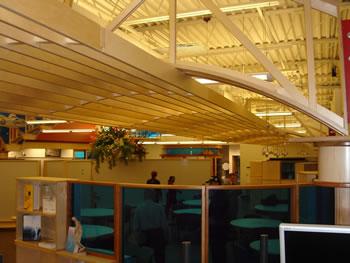 |
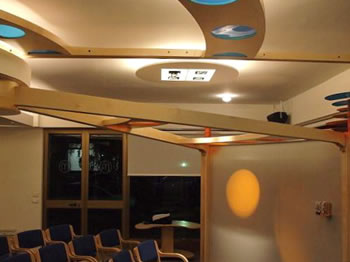 |
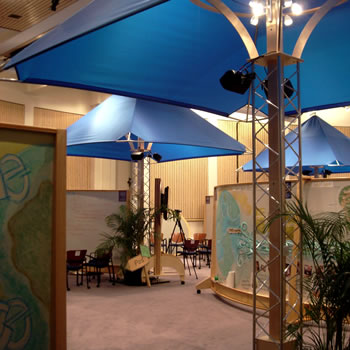 |
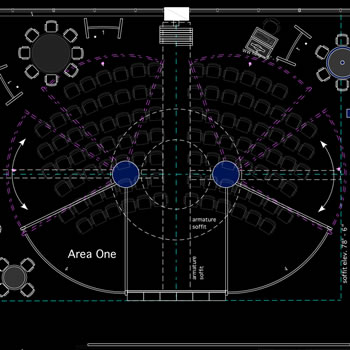 |
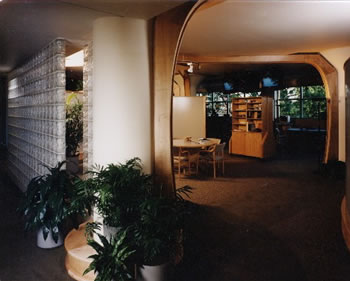 |
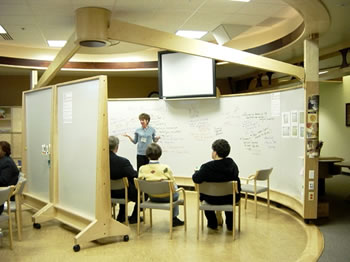 |
 |
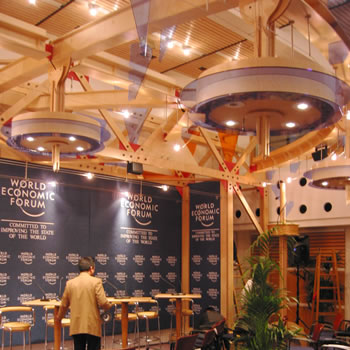 |
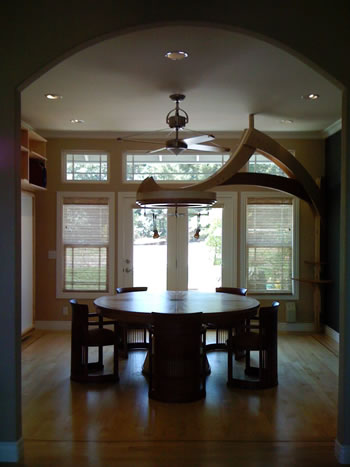 |
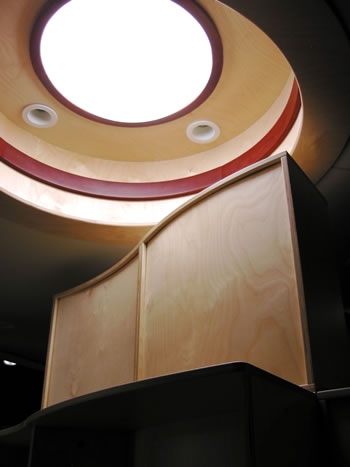 |
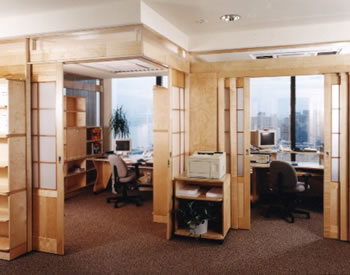 |
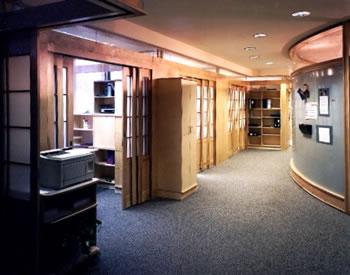 |
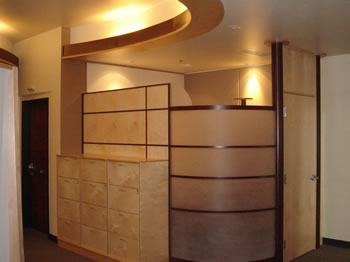 |
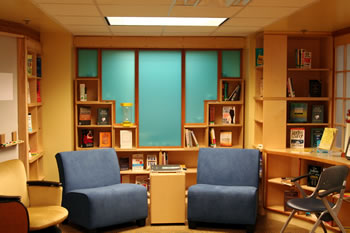 |
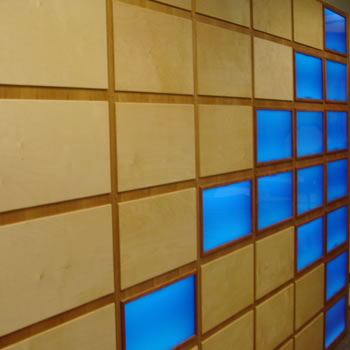 |
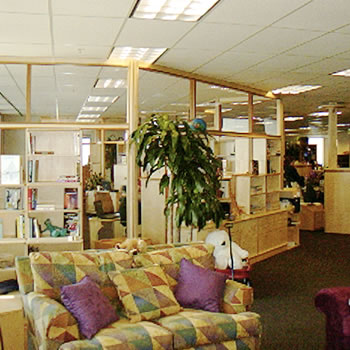 |
 |
click on graphics below to visit three built, and one concept, Taylor environments |
|
|
| The Rate of Change and increase in Complexity in our global society is increasing. The rate of the rate is changing not just the magnitude. This change is non linear and induced by human activity itself. There will be as much change in the next generation than since the beginning of human history. Individuals and organizations will have to recreate themselves over and over to stay requisite with this change. This will require creativity on all levels of society including our professions and organizations. The rate and scale of this is unprecedented in human history. Education today is life long and an integral part of living and work. What we learned in our “education years” is no longer adequate for a career. The viable organization will tightly integrate learning and work activities. Learning implies much more than traditional training. New techniques and methods will be required in the corporate university just as they will be in the shop, factory, technical disciples and management. What we are experiencing today, is the consequence of many failures in governance and it is something more: it is the first indication of a global, systemic, transformational change in how we see the world, relate to it, employ technology and run our businesses. |
|
|
| Systematic Learning and Collaborative Design Methods must now be core competencies of the modern organization. This requires more than talent, willingness and a mandate from management. It requires method. Not only method related to learning and design collaboration - method which systematically integrates the growing knowledge of the organization and relates present and future organizational requirements to each individual’s curriculum. By organization, I do not mean the traditional model of a corporation, government, NGO, professional practice, political party, the Boy Scouts, or local, “mom and pop”business. The practice of organization is rapidly changing. The distinctions between kinds of organizations are blurring - sometime for very good and other times for disastrous results. Organizational models are important yet there are many which are appropriate for a time and place and these also will have to change when circumstance require it. The organization, now, is a tool like any other. Spirit, culture, the passion for a product or service, the desire to innovate and create - these are more enduring than the legal structure of an enterprise and sometime even the name on the door. Enterprises now form ValueWebs to accomplish what they cannot do alone. |
|
|
|
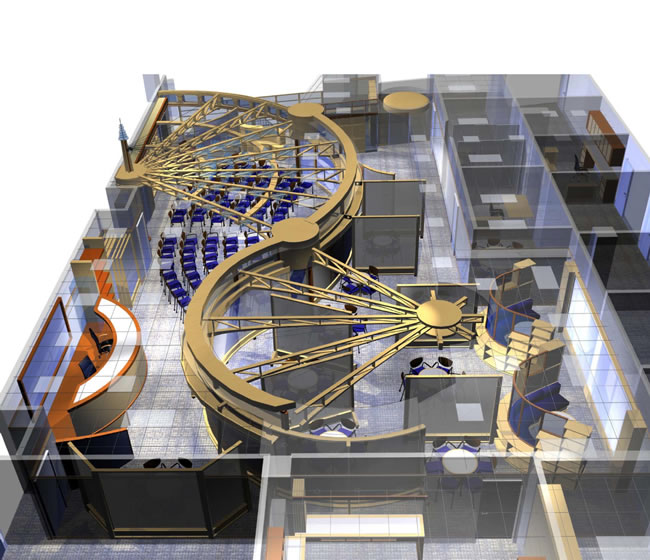 |
| In the Knowledge and Design Economy, the primary factory of an enterprise is its learning and collaborative design environments. Yet, most treat the economics of these like the training centers of old: a necessary cost but one to be kept down like other regrettable overhead expenses. By shifting the paradigm and applying the financial logic appropriate to a production facility, a different set of answers prevail. This is not to argue for misplaced extravagance - it is to apply the same rigor - capital investment and expected measurable return - as is appropriate to the selection of production tooling. The value of an organization, in the end, is a factor of its real human capital. The learning organization, capable of collaboration and systematic innovation, is able to focus its total human capital with its customer to serve its customer. We call this GroupGenius®. The results are extraordinary, when measured by today’s standards, yet today’s extraordinary results will be mundane when measured by tomorrow’s requirements. Value add has shifted from resource control, to manufacturing, organizational structure, to financial leverage and now to the application of knowledge and design abilities. We are hunter gatherers traveling through a landscape of knowledge and opportunities, forming ad-hoc tribes to conceive, design, manufacture and market a product-service then moving on to another opportunity. The organization supports. |
|
|
| Humans are extraordinarily adaptable. We invent and employ technology to make us even more so. This skill has made us complacent and short term focused. Our hidden design assumption is that no matter the crises - after we have hit the wall - we will solve it. This design “strategy” has become a permanent unintended consequences generator. Humanity is creating the conditions which are becoming our own evolutionary drivers. In doing so, we often trade down rather than solve problems in a way which achieves comprehensive solutions offering both short and long term viability. Systemic problems are intrinsic to any system which cuts across many organizational, cultural and political-economic domains. This requires an unprecedented level of collaboration as traditional policies and processes fail. Added to this mix is a cascade of technological innovations which gives us more power, not necessarily more wisdom. Great opportunity comes with great risk. |
The Mission of MG Taylor is to provide the means for individuals and organizations to radically reduce the-time-to-value of learning and problem solving processes while greatly enhancing the quality of outcomes. Emplying a ValueWeb architecture, we design, manufacture, build, operate and transfer to users, 21st Century knowledge factories.
|
|
|
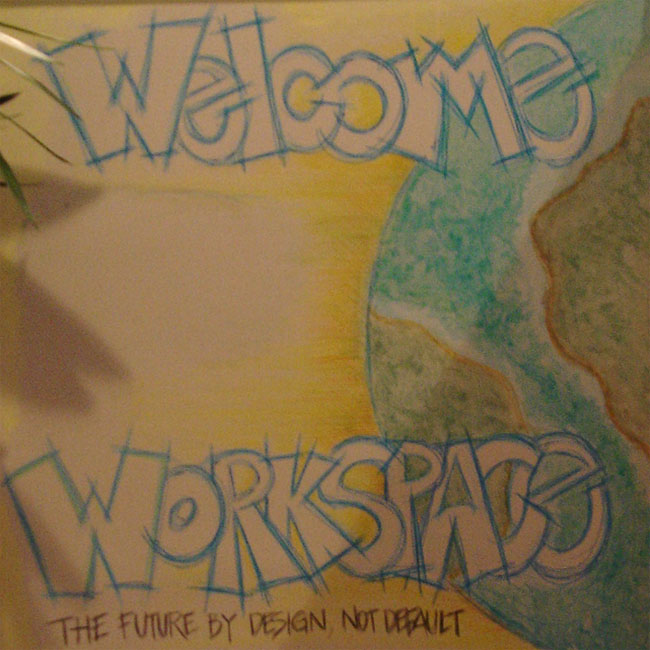 |
click on graphics below for added detail |
|
posted: November 12, 2008 • last revised December 12, 2008 |
Copyright© Matt
Taylor 2008 |
|
